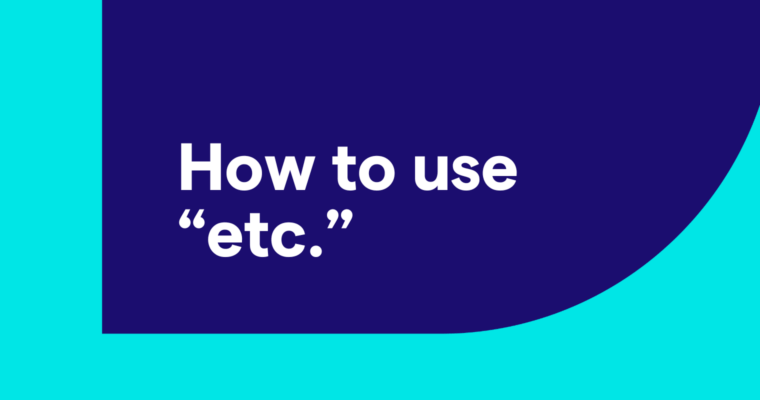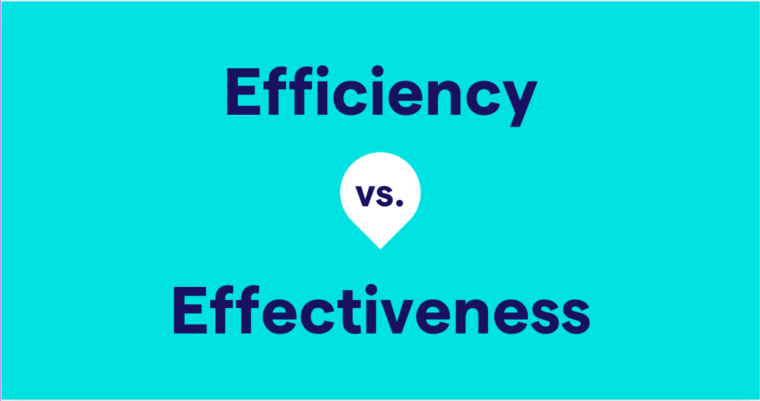
- Et cetera is a Latin phrase. Et means “and.” Cetera means “the rest.”
- When you begin a list that you will not complete, etc. indicates that there are other items in the list besides the ones you explicitly mention.
- The abbreviation of et cetera is etc.
- The abbreviation is more common than the full phrase in business and technical writing.
You’ve undoubtedly encountered the phrase et cetera in texts. If you don’t recognize et cetera, you probably recognize its abbreviation: etc. Et cetera is used with lists to communicate that there are items in the list that you haven’t explicitly mentioned. This could be because those items are yet to be determined, not relevant to the written list, or you need to save space on the page. In any case, etc. communicates that there’s more to the list than you’ve explicitly stated. In this blog post, we’ll show you how to use etc. correctly and how to use etc. in a sentence.
Table of contents
Examples of how to use etc. in a sentence
Use etc. to keep your writing concise
How to use etc. correctly FAQs
What does et cetera mean?
Et cetera is a Latin phrase that means “and the rest.” In English, it’s used to communicate that there are more items in a list, but those items aren’t specifically listed. Et cetera is often abbreviated to etc.
How to pronounce et cetera
Et cetera is pronounced et-SET-uh-ruh. You might have heard it pronounced ek SET ra, but this is incorrect. There is no “k” in et cetera, which is why “ek set ra” is not correct.
This is a common mistake that Americans make when pronouncing et cetera. Mispronunciation when saying a foreign phrase is known as assimilation, and it’s very common. If you know it, you can avoid making the same mistake and recognize the phrase even when you hear it mispronounced.
People may also extend the meaning of certain foreign phrases beyond their original definition. To English speakers, et cetera often appears when someone finds a list tedious or obvious. They might utter it in a tired tone or say the phrase rapidly.
When to use etc.
Use etc. when you don’t have the space and/or need to name all the items in a list. Here is an example:
In this sentence, etc. demonstrates that there is more to the list than what’s written out. To get a bit more specific, here’s how to use etc. in a sentence:
Use etc. to show that a list of at least two items is incomplete
Only use etc. after two or more items. In other words, if you’ve only listed one example, it’s incorrect to follow it with etc. Additionally, the items listed must be in the same category.
For example, “Please buy our weekly vegetables: broccoli, squash, peppers, etc.” is correct, but “Please buy items we need for the house: broccoli, light bulbs, etc.” is not.
Use etc. to mean “and so forth” or “and so on”
Etc. can also mean “and so forth” and “and so on.” However, when you use it this way, it must adhere to the other established rules for et cetera, like using it after two or more items and only using it if the items listed logically fit into the same category. In fact, you can double-check if you’ve used etc. correctly by substituting “and so on” or “and so forth.” If the sentence makes sense, you’ve used etc. correctly.
Here’s an example:
Using et cetera vs. etc.
So, should you use et cetera or etc. in your writing?
That depends on how formal your writing is. Etc. is an abbreviation, which essentially means it’s shorthand. Save it for informal pieces of writing like emails and blog posts. For more formal writing, like an academic paper, spell out et cetera—but there’s a caveat to this.
Sometimes, it’s best to leave et cetera out of your academic writing completely. This is because et cetera could be construed as vague, potentially leaving the reader with incomplete information. In a piece of academic work, accurate, comprehensive information is necessary. However, if you’re citing a quote that includes etc. or et cetera, include it as part of the quote.
Here’s another exception to the general rule of saving etc. for informal writing and using et cetera in more formal communication. In business and technical writing, etc. is used frequently.
Use the correct spelling of etc.
There are a few accepted spellings for et cetera. The two most common are et cetera and etcetera. Others include et caetera, et cœtera, and et coetera.
Avoid common misspellings like ect. and cet.
When to avoid using etc.
Here are the instances when etc. is not appropriate:
When you’ve used it once already
Use etc. only one time per sentence. Sometimes, people will use etc. twice to stress that there’s more to a list, but this is incorrect.
When introducing a list of people
Do not use etc. when you’re introducing a list of names. Instead, use et al, the abbreviation of et alii. Et alii means “and others.”
However, etc. is the correct choice when listing non-specified people:
When there’s no clear connection between the listed items
Etc. is only appropriate when the items listed are in the same category. This is subjective—but when the items listed are not obviously connected, avoid etc.
When you’ve mentioned every possible item in the list
If you’ve mentioned every item in a list, there’s no need to include etc. Doing so can confuse readers, as it implies there’s more to the list.
For example, “It was painted in primary colors: blue, red, and yellow” would not include etc. because the three primary colors are already listed.
When you’ve introduced the list with e.g., for example, or for instance
E.g. is another abbreviation of a Latin phrase that’s used as shorthand in English. It stands for exempli gratia, and it means “for example.”
Do not use e.g. in the same list as etc. They cancel each other out, so choose the one that best expresses your sentence’s intent. Take a look at these two examples:
After and
Don’t use etc. after the word and. This is because in et cetera, the word et means and, thus making it redundant. If you follow and with et cetera, you’re essentially writing “and and others.” Choose one structure or the other:
How to punctuate etc.
Etc. always ends with a period, as it’s an abbreviation. Here are more punctuation rules for how to use etc. in a sentence:
Comma with etc.
In a list with two or more items, use a comma between the last item and etc.
If there’s more to include in the sentence after etc., follow it with a comma:
Period after etc.
No matter where etc. appears in a sentence, follow it with a period. If it’s the last word in a sentence, only one period is needed to end the sentence:
If there’s more to include in the sentence after etc., end the sentence with a period, question mark, or other punctuation as you normally would.
Other punctuation with etc.
When ending a sentence with etc., and the sentence doesn’t end with a period, include the final punctuation mark—such as an exclamation mark—after the period. Here are a few examples:
When etc. is the last word in a clause that ends with a semicolon, add a space before the next word:
When necessary, put a parenthesis around the whole list ending in etc.:
Examples of how to use etc. in a sentence
Use et cetera to keep your writing concise
Et cetera is helpful shorthand because by including it, you can avoid writing long lists that may feel redundant and lose readers’ attention. It communicates that there’s more to a list and that you’ve provided just a few examples. Use it to make your writing more efficient and focused on your main ideas.
How to use etc. correctly FAQs
What’s etc. an abbreviation of?
Etc. is an abbreviation of et cetera.
What’s the meaning of et cetera?
Et cetera means “and the rest.”
When should you use etc.?
Use etc. when you’re writing a list but don’t want (or need) to write out every single item in the list. Be sure only to use it if you’re giving two or more examples from the list.
How do you use periods and commas with etc.?
Etc. always ends with a period. When etc. is the last word of a sentence, one period is sufficient. You may use a comma after etc. if a comma would otherwise be correct in that position within a sentence. If you’re ever not sure, swap “and the rest” for etc. and if it makes sense, you’re using it correctly.






